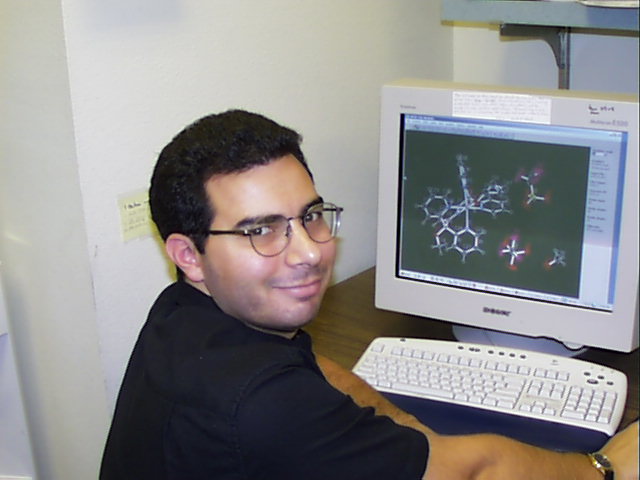Graduate Student
Born in 1975. USA.
Education: Harvard University (Cambridge, MA); A.B. in
Chemistry, 1998. R. H. Holm, advisor.

| crgoldsm@stanford.edu
Graduate Student
Born in 1975. USA.
|
 |
Interests in the StackLab: Lipoxygenase Models
Lipoxygenases are mononuclear non-heme iron enzymes that catalyze the
oxidation of 1,4-pentadiene containing fatty acids to alkyl hydroperoxides.
The hydroperoxide products are precursors to a number of physiological
effectors such as leukotrienes and lipoxins, and lipoxygenase activity
has been linked to a number of inflammatory conditions as well as angiogenesis
in certain forms of cancer. Lipoxygenase oxidation is generally believed
to occur through an initial hydrogen atom abstraction from the 3-position
of the 1,4-pentadiene subunit by an Fe(III)-hydroxide species to form an
organic radical and an Fe(II)-water species. The organic radical rearranges
before molecular oxygen is regio- and stereospecifically incorporated into
the molecule. The resultant alkyl peroxide radical then abstracts a hydrogen
atom from the Fe(II)-water species to regenerate the Fe(III)-hydroxide
form of the enzyme. Our lab has developed a small molecule mimic of the
active form of the enzyme. Using the pentadentate ligand PY5 to model the
histidine-heavy coordination sphere of lipoxygenase, we made the complex
[Fe(III)(PY5)(OMe)]2+, which is capable of cleaving weak (< 90 kcal/mol)
C-H bonds. Primary kinetic isotope effects are observed with deuterated
substrates, and the reactivity scales with the bond dissociation energy
of the C-H bond. Both of these observations are consistent with a hydrogen
atom abstraction as the rate-determining step in the mechanism. Currently,
efforts to generate a second generation of lipoxygenase mimics are underway.
Publications: (click on the number to get the pdf file)
(7) Hydrogen Atom Abstraction by a Mononuclear Ferric Hydroxide Complex:
Insights into the Reactivity of Lipoxygenase
Goldsmith, C. R.; Stack, T. D. P.
Inorg. Chem.2006, ASAP.
(6) C-H Activation by a Mononuclear
Manganese(III) Hydroxide Complex: Synthesis and Characterization of a Manganese-Lipoxygenase
Mimic?
Goldsmith C.R., Cole A.P., Stack T.D.P.
J. Am. Chem. Soc. 2005, 127. 27, 9904-9912.
(5) X-ray Absorption Spectroscopic
Investigation of the Spin-Transition Character in a Series of Single-Site
Perturbed Iron(II) Complexes
Jackson Rudd D., Goldsmith C.R., Cole A.P., Stack T.D.P., Hodgson K.O.,
Hedman B.
Inorg. Chem. 2005, 44, 5, 1221-1229.
(4) A Spectrochemical Walk: Single-Site
Perturbation within a Series of Six-Coordinate Ferrous Complexes
Goldsmith C.R., Jonas R.T., Cole A.P., Stack T.D.P.
Inorg. Chem. 2002, 41, 18, 4642-4652.
(3) A Periodic Walk: A Series of First-Row
Transition Metal Complexes with the Pentadentate Ligand PY5
Klein-Gebbink R.J.M., Jonas R.T., Goldsmith C.R., Stack T.D.P.
Inorg. Chem. 2002, 41, 18, 4633-4641.
(2) C-H bond activation by a ferric
methoxide complex: Modeling the rate-determining step in the mechanism
of lipoxygenase
Goldsmith C.R., Jonas R.T., Stack T.D.P.
J. Am. Chem. Soc. 2002, 124, 1, 83-96.
(1) Synthesis, structures, and reactivity of bis(dithiolene)molybdenum(IV,VI)
complexes related to the active sites of molybdoenzymes
Donahue J.P., Goldsmith C.R., Nadiminti U., Holm R.H.
J. Am. Chem. Soc. 1998, 120, 49, 12869-12881.